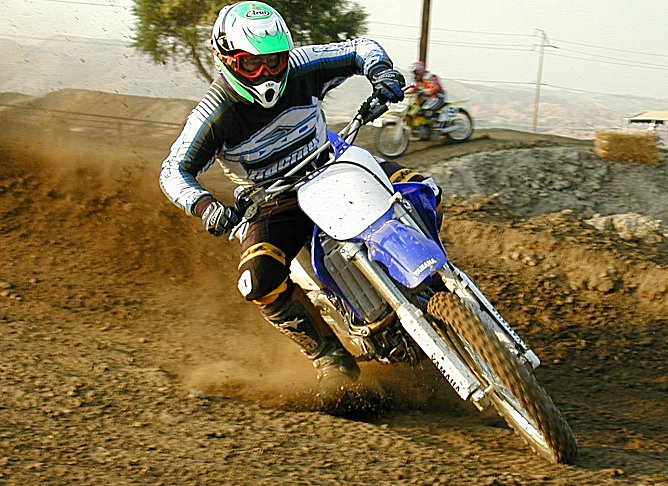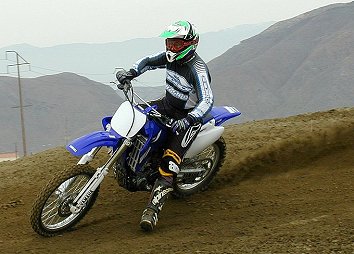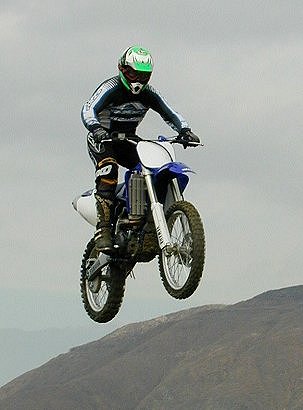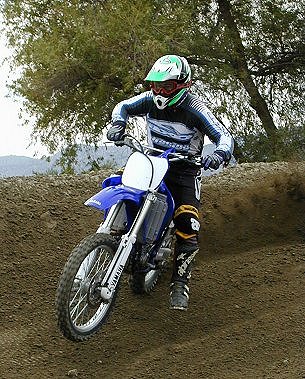
There are very few motorcycles, dirt or street, which deserve the label “benchmark”. We could argue about which motorcycles deserve that label, but at least one motorcycle leaves no room for argument: Yamaha’s 1998 YZ400F motocrosser.
The 1998 YZ400F unexpectedly took the motocross world by storm. Why do I say “unexpectedly”, because the initial reaction of die-hard motocross fans and riders (before they had a chance to ride the bike — or see reviews of the bike) was predictable. My reaction, and the reaction of many others, was “That’s interesting, but it will never be as good as a two-stroke on a motocross track.” How wrong we were.
Now in its fourth model year, the YZ426F (the direct descendent of the original YZ400F) is no longer an unexpected surprise. Doug Henry’s outdoor national motocross championship, along with countless favorable press reviews and thousands of satisfied customers, proved Yamaha’s concept. Indeed, the success of this bike greatly exceeded even Yamaha’s expectations.
Who would have expected that no other Japanese manufacturer would have a four stroke motocross bike on the showroom floor for the model year 2001? The YZ400F was so revolutionary, and so well-designed, that Yamaha’s capable Japanese competition have yet to respond with a production bike of their own. This is an absolutely amazing fact, given two circumstances: (1) the huge market Yamaha has opened up for four-stroke motocross machines, and (2) the introduction to the public of the YZ400F in June of 1997 – more than three years ago!.
This article isn’t about the history of Yamaha’s ground-breaking motocrosser, but this background is necessary to understand the following ride review.
For 2001, Yamaha has taken its lightweight and powerful, five-valve, 426cc single and given it titanium valves. With the valves now more than forty percent lighter than last year’s valves (and, remember, Yamaha has five of them in this head), the valve springs can be designed lighter and softer, allowing a quicker revving engine and improved throttle response.

Yamaha also incorporates a new exhaust pipe (thankfully, allowing the oil filter to be removed without removing the exhaust header — something that was necessary on prior models), as well as revised carburetor settings. The carburetor changes were aimed at two gremlins, including (1) an off-idle stumble, and (2) difficult starting (particularly while hot).
Changes to the frame material and rear swingarm material allowed weight reduction without sacrificing strength (in fact, Yamaha claims improved strength) and stiffness. The rear, aluminum subframe is 10mm lower for a flatter seating position.
Changes to the forks and shock reduce friction, improve the “bottoming” feeling (and remove the “clank” heard by riders last year), as well as reduce unsprung weight in the rear. Aside from the titanium valves, the biggest news (shared by all other YZs, both four-stroke and two-stroke) is the revised front brake featuring an all new master cylinder and larger 250mm disc.
The engine on the 2001 YZ426F clearly revs quicker than last year’s model, and the stumble at the very low end of the rev range is gone. Power is also improved.
The quick response of this engine makes it unlike any other four-stroke single-cylinder engine on the market. It absolutely snaps out of corners while retaining the smoother delivery of a four-stroke and the easier throttle control compared to a two-stroke. 250cc two-strokes have absolutely no chance of hanging with the YZ426F exiting corners. Not only does the motor hook-up better (as you would expect from a four-stroke), the torque is significantly higher than that of a two-stroke 250.
Those of you who had the privilege of watching Jimmy Button ride the factory YZ426F in supercross last year (before his injury) may remember how Button could take the inside line on corners before double jumps, yet easily clear the jumps when 250cc two-strokes needed to take the outside line in the prior corner to gain enough momentum. It was a dramatic advantage for Button, and amateurs will have a similar advantage riding the titanium-valved 426 this year.

The fork and shock (particularly the fork) take quite a while to break in. Initially, the suspension seems very stiff, and even harsh. Be patient. After two or three hard rides, the suspension becomes much more supple. In the end, I was very pleased with the fork and the shock on this bike. The spring rates are stiff (as they should be, given the weight and purpose of this machine), but the valving seems excellent, and the combination worked well for my 200 pound frame. Ultimately, I left the suspension settings the way the factory delivered them, with just one click less rebound damping on each of the front forks. Of course, you need to set the sag of the rear shock correctly for your weight (at approximately 100mm).
One trade-off with the 426 is weight. The bike is clearly heavier than a two-stroke 250, and you do notice it in certain situations. One of them is braking. It is definitely more difficult to haul down the 426 than it is a 250 going into corners. The engine braking of the four-stroke motor helps compensate for this, somewhat, however. Also, you are able to get on the gas more quickly and effectively on the 426, and your corner exit speeds should be higher.
Somewhat surprisingly, the weight of the 426 is less of a factor while jumping. The engine characteristics described above made it easier for me to clear obstacles on a motocross track than most 250s I have ridden, and the 426 has a very neutral feeling in the air. The titanium valves also seem to translate into slightly less engine braking than prior years, making the transition from a two-stroke a little bit easier, particularly with regard to jump takeoffs.
You may recall Doug Henry dropping the front end of his four-stroke too much (and nearly endoing, at times) while he was getting used to jumping the bike. You do need to avoid chopping the throttle on the jump face with any four-stroke, because added engine braking will drop the front end in the air. For some reason, I had no trouble with this when I rode the new 426, however, and I attribute it, in part, to the lighter valve train and slightly reduced engine braking.
The added weight is an advantage in one respect. The additional weight (coupled with the increased gyro-effect of the larger crank) means this bike wants to go straight, and gobbles up rough straights superbly. The stability is felt on jumps, as well.
The carburetor tweaks seem to have cured the starting problems associated with the 426 and its predecessors. After following the correct ritual (finding top dead center, taking the kick stroke just past that point — with the compression release pulled in — and then, with the compression release out, kicking through swiftly), the bike most frequently starts on the first kick. Make sure you take the time to learn the ritual or you will buy significant frustration.

Carburetor changes, as I mentioned earlier, also have corrected the stumble off idle. I experienced nothing of the sort. In fact, the bike pulls from way down low smoothly and with authority.
The ergonomics of the YZ426 are a good compromise, and are borrowed from the Yamaha two-stroke line. Lowering of the rear subframe, and the movement of the handlebar mounting position forward (something that occurred last year) seem to work. Yamaha could use a flatter seat, however, to allow the rider to move more freely forwards and backwards.
Yamaha’s engineers also beefed up the clutch this year. Prior YZ426s and 400s had some clutch reliability problems. Yamaha attempted to address this with detail changes in the new clutch. We experienced no problems with the clutch, whatsoever, during our testing.
The clutch worked well with the shifter — we experienced virtually no missed shifts during our testing, and shifts were smooth and positive.
It is no secret that several magazine editors personally ride YZ426F motocrossers. When the guys who can, and do, ride everything available choose the YZ426F, it says a lot. If you are coming from a two-stroke 250, be patient. It takes several rides to get used to the YZ426F (or any four-stroke, for that matter).
Your patience will be rewarded with a less fatiguing motorcycle, and engine power delivery that will put a smile on your face (and a frown on the face of the guy you roosted exiting the last corner).
The 426F should be available now at your Yamaha dealer. U.S. MSRP is $5,999.





